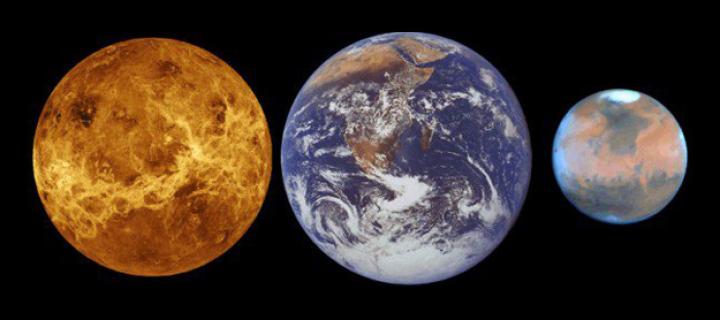Both of our neighboring planets, Venus and Mars, are carbon dioxide (CO2) worlds. On Earth, there is only a trace amount. So why all the fuss about carbon dioxide? In half a minute, you can fully grasp how CO2 does its dirty work. Interested?
Earth’s Carbon Dioxide Levels
Six years ago, for the first time in 800,000 years, our own world’s carbon dioxide level passed 400 parts per million (ppm). This was the milestone we’d long been anticipating. CO2 was just 330 ppm when the Beatles were big. Before the industrial revolution, and going back for almost a million years, the level was 280 ppm. It now stays above 400 ppm permanently.
Yet, carbon dioxide still makes up only 1/25th or 1% of the air. When you take a breath, you inhale 500 times more oxygen than you do carbon dioxide. So why the fuss?
How Carbon Dioxide Works
We’ve all heard about “greenhouse gases,” and know that carbon dioxide is big player in this arena, along with methane and water vapor. But you may not know how simple is the mechanism by which greenhouse gas does its dirty work. I’ll explain.
- Sunlight warms the ground during the day.
- At night, this energy radiates back into space (in the form of infrared rays) and it cools down. Got it?
Here’s the key point: when the infrared rays from the ground travel up through the air and encounters these atoms and molecules, it keeps going in a straight line and continues into space. That’s how the ground cool during the night.
Now, what is air made of? Earth’s air is about 80% nitrogen, 20% oxygen, and 1% argon. Yes, argon is the third most common gas! See my post about what air is made of. Nitrogen and oxygen atoms commonly bond into twosomes to form the molecules N2 and 02, while argon is a loner and exists as just a plain atom.
But a molecule with 3 or more atoms acts very differently during its infrared encounters. Other gases—methane (CH4), carbon dioxide (CO2), and water vapor (H20)—have between 3 and 5 atoms apiece. When infrared strikes any of them, it gets absorbed by the molecule, which then quickly re-radiates it in random directions. Those three words are the critical key. So instead of continuing upward into space, the infrared now goes sideways or upward or downward. The downward ones re-heat the surface a bit.
That’s the whole story. And this explains why on cloudy nights when there’s lots of water vapor overhead, the ground doesn’t cool as much as it does on a clear night. The more methane, water vapor, or carbon dioxide is in the air, the less each night can cool down.
So greenhouse gases mainly do their work during the night. They raise a region’s nightly low temperatures. It’s as inevitable as the sunrise.
Venus and Mars: Carbon Dioxide Worlds
Now let’s consider that the two brightest nocturnal objects after the Moon are Venus – dazzling in the east just before dawn – and Mars, brilliant all night long. Both worlds’ atmospheres are almost pure carbon dioxide.
- Venus is 96% carbon dioxide (CO2) which led a once Earthlike planet to a very high surface temperature (over 800 degrees). As Venus got hotter and hotter, its oceans evaporated.
- Planet Mars is 95% carbon dioxide (95%). Its CO2 forms dry ice clouds. As Venus became hot and dry, Mars became cold and dry.
Both planets have much warmer surfaces as a result. Even though it’s further from the Sun, Venus is the hottest planet in the solar system, while the martian surface is boosted to a comfortable 45° because of the CO2.

Back to Earth
Carbon dioxide creates very different stories on Earth and our neighbors.
Our planet would also be mostly carbon dioxide, too, if this gas were not locked up in in the rocks of our crust or dissolved by the water in our oceans. Neither Mars nor Venus have liquid water. However, our trees, plants, soil, rocks, and oceans can only lock up so much carbon.
Here, increased CO2 will also change climate and countless other things in mostly (but not entirely) undesirable ways.
On Venus, it long ago created a literal hell, with a surface exceeding that of a wood stove and a pressure 50 times greater than that of a pressure cooker. It’s an impossible place, a “keep out” zone.
But on Mars, it fashioned a surface that would have been forbiddingly frozen but now warms to 45 degrees or so, thanks to the CO2, offering, at least in our fantasies, a future potential colonization venue. (It will never happen, in my opinion, and I’ll explain why in a future article.)
For the moment, we can see three worlds deeply fashioned by that gas beloved by the botanical world.










